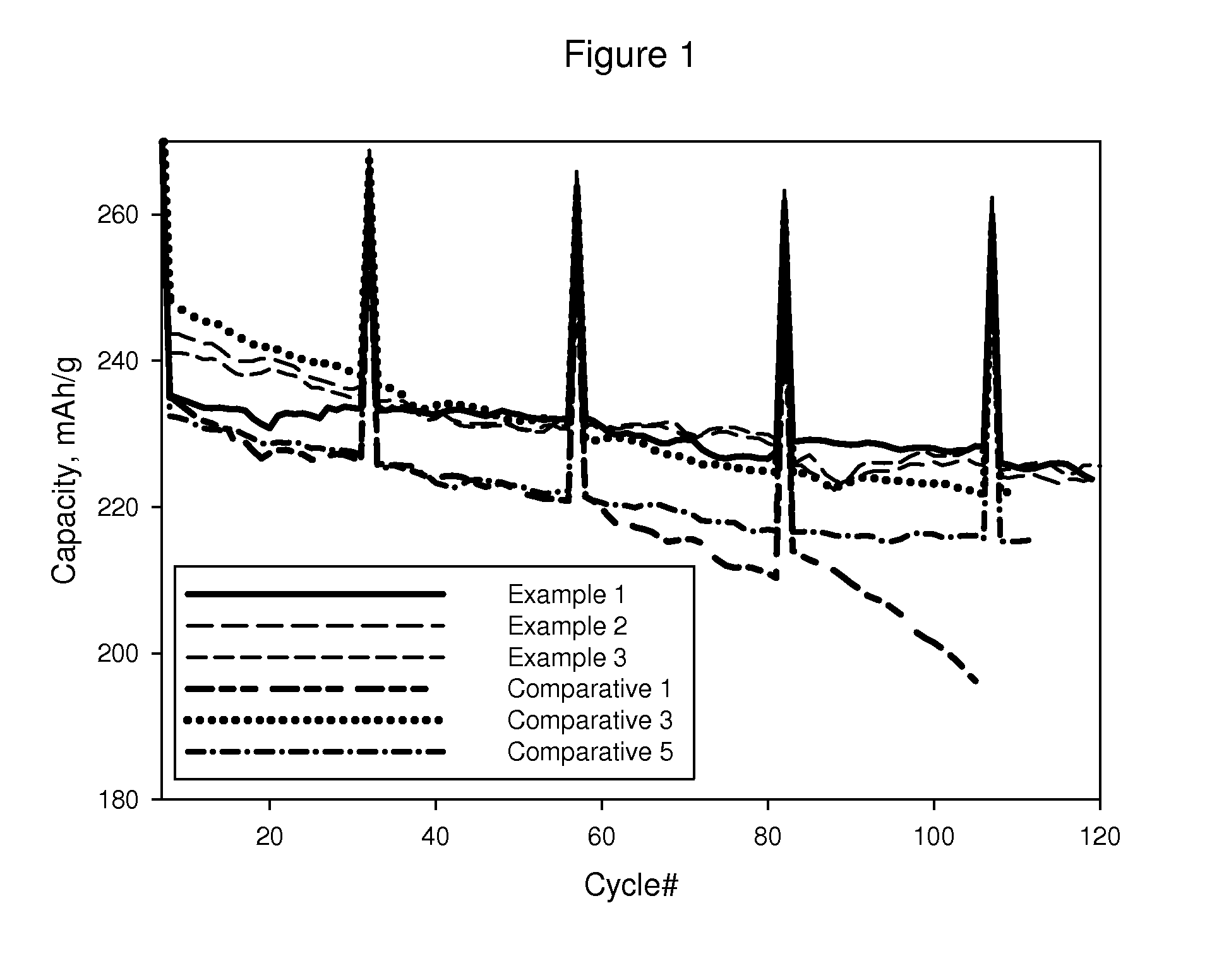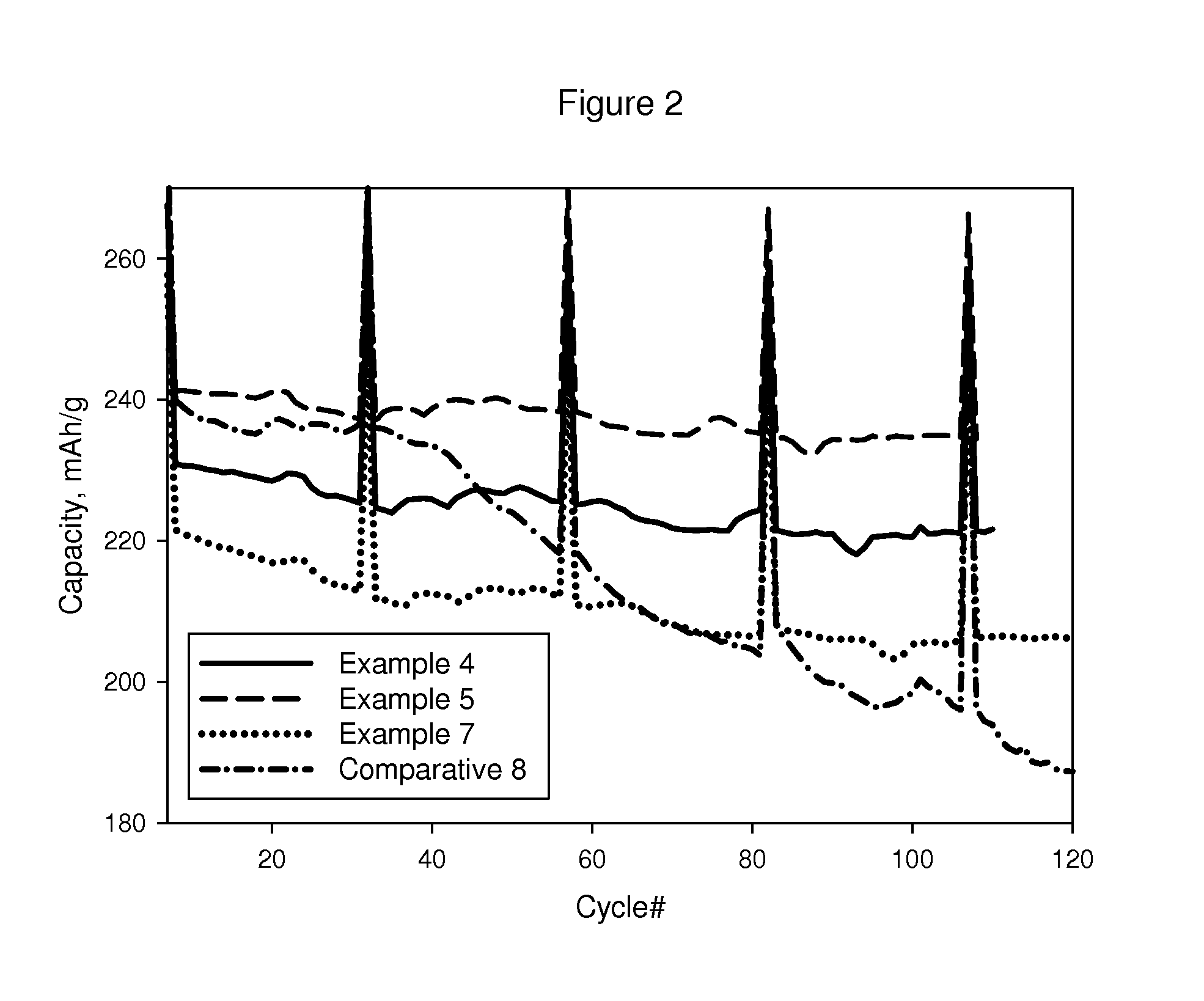Improved lithium metal oxide cathode materials and method to make them
a lithium metal oxide and cathode material technology, applied in the direction of batteries, sustainable manufacturing/processing, nickel compounds, etc., can solve the problems of short cycle life of materials and significant reduction of other properties such as initial specific discharge capacity, and achieve the effect of improving the performance of lmos and enhancing the cycle life of libs
- Summary
- Abstract
- Description
- Claims
- Application Information
AI Technical Summary
Benefits of technology
Problems solved by technology
Method used
Image
Examples
example 1
[0050]In a beaker, 1.12 g of aluminum nitrate nonahydrate (Al(NO3)3.9H2O) and 1.30 g lanthanum nitrate hexahydrate (La(NO3)3.6H2O) were dissolved in 4 ml of water and set aside. 18 ml of water was added to a 250 ml three-neck round-bottom flask equipped with a condenser and overhead stirring. Stirring was initiated at 200 RPM and 25.0 g LMO 1 was added to the flask, resulting in a black slurry. The pH of the slurry was then measured, pH=10.60. The aluminum nitrate and lanthanum nitrate solution were then quickly added to the slurry. The pH was then measured, pH=4.95. A pipette was then used to add 9 ml of 2M ammonium hydroxide (NH4OH) solution to the slurry at a rate of 2 ml / min. After the addition, the pH of the slurry was measured, pH=9.82. The open neck of the flask was then closed with a septum. A thermometer was then inserted through the septum into the slurry.
[0051]With continued stirring, a heating mantle was used to heat the slurry to 50° C. The slurry was stirred at 50° C. ...
examples 2 and 3
AND COMP. EXAMPLES 2 TO 6
[0058]In these Examples the same procedure was used to make coated LMO 1 as in Example 1 except that the amount of the compounds used were changed to realize the coating compositions shown in Table 2. When the composition employed yttrium, the compound dissolved was yttrium nitrate hydrate.
[0059]In Example 2, the preparation was identical to Example 1 except that only half the amount of lanthanum nitrate hydrate was utilized to give a final loading of 1.6 wt % lanthanum aluminum oxide
[0060]In Example 3, yttrium nitrate hydrate was employed. In a small beaker, 0.91 g Al(NO3)3-9H2O and 0.93 g Y(NO3)3-6H2O were dissolved in 4 ml of deionized water and set aside. 14 ml of deionized water was added to a 250 ml three-neck round-bottom flask equipped with a condenser and overhead stirring. Stirring was initiated at 200 RPM and 20.0 g LMO 1 was added, resulting in a black slurry. The pH of the slurry was then measured, pH=11.30. The aluminum nitrate and yttrium nitr...
examples 4 to 8
[0068]Examples 4 to 8 were made the same way as described in Example 1, except that LMO 2 was used and the calcination temperature that was used to finally form the coating was as shown in Table 3.
[0069]In making Examples 4 to 8, a 100 g portion of LMO 2 was coated with 2.6 wt % lanthanum aluminum oxide as described in Example 1 and dried in a 100° C. oven overnight. The resultant solid was divided into five equal portions each of which was then calcined to a different final temperature for four hours. The temperatures utilized were 150, 400, 550, 700, and 850° C. after which the furnace shut off and was allowed to cool to room temperature. Once cool, the black solids were collected and weighed. The solids were sieved to under 45 microns before being submitted for electrochemical testing and analytical characterization.
[0070]The best capacity vs cycling performance was realized with the 400° C. treatment as shown in FIG. 2.
PUM
| Property | Measurement | Unit |
|---|---|---|
| Temperature | aaaaa | aaaaa |
| Temperature | aaaaa | aaaaa |
| Fraction | aaaaa | aaaaa |
Abstract
Description
Claims
Application Information
 Login to View More
Login to View More - R&D
- Intellectual Property
- Life Sciences
- Materials
- Tech Scout
- Unparalleled Data Quality
- Higher Quality Content
- 60% Fewer Hallucinations
Browse by: Latest US Patents, China's latest patents, Technical Efficacy Thesaurus, Application Domain, Technology Topic, Popular Technical Reports.
© 2025 PatSnap. All rights reserved.Legal|Privacy policy|Modern Slavery Act Transparency Statement|Sitemap|About US| Contact US: help@patsnap.com


